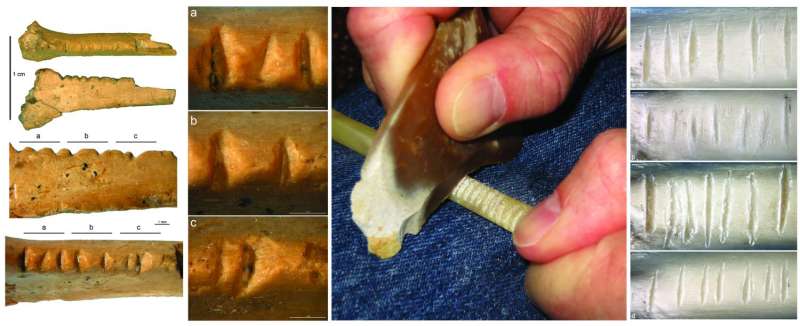Decorated bird bone suggests Neanderthals had eye for esthetics

A 40,000 year old piece of raven bone that was etched with near-even lines suggests Neanderthals had an eye for esthetics, French researchers said Wednesday.
Neanderthals, who were cousins of modern men and who disappeared some 38,000 years ago, are known to have used pigments and collected bird feathers and shells, sometimes burying objects with the dead.
Now, the 1.5 centimeter piece of bone found at an archeological site in Crimea suggests they may have etched lines in a way that appeared deliberate, and may have been symbolic or decorative.
Microscopic analysis showed that six grooves were added at first, and two more later, perhaps to make the distance between them more even.
"We could therefore show that Neanderthals made etches with the intent of creating a visually harmonious—and perhaps symbolic—motif," said researcher Francesco d'Errico, a paleontologist with the University of Bordeaux, and lead author of the study in the journal PLOS ONE.
"There was at least some esthetic reason for these marks because of their regularity, and the act of producing this in a deliberate manner requires a certain level of expertise," he told AFP.
The study was described as "the first that provides direct evidence to support a symbolic argument for intentional modifications on a bird bone," said a statement from the journal.
Neanderthals lived around 200,000 years ago, and existed alongside modern man for about 10,000 years.
Scientists say the last trace of Neanderthals goes back about 38,000 years.
But they have not totally disappeared. Due to interbreeding with modern people, humans inherited between two and four percent of Neanderthal genes.
More information: Majki A, Evans S, Stepanchuk V, Tsvelykh A, d'Errico F (2017) A decorated raven bone from the Zaskalnaya VI (Kolosovskaya) Neanderthal site, Crimea. PLoS ONE 12(3): e0173435. journals.plos.org/plosone/arti … journal.pone.0173435
Journal information: PLoS ONE
© 2017 AFP





















